Your Planets
Portraits of the Planets
Aspects between Planets
The planetary ages
The planetary families
Planets in Signs
The Planets in comics


Traditionally, astrology is based on the Planets-Zodiac-Houses triptych. Drawing up a map of the sky amounts to inserting the celestial sphere (whose center is that of the Earth) in the local sphere (whose center is the eye of the observer). No interpretation of a chart worthy of the name can avoid, according to the so-called “traditional” astrology, the analysis and synthesis of the positions of the planets in Signs and in Houses, which amounts to fitting three frames of reference: the heliocentric (Planets), the geocentric (Signs) and the topocentric (Houses). That said, if the planetary and zodiacal meanings seem much better understood and elucidated today, the same is not true with regard to the meanings of the sectors of the local sphere, even if certain contemporary authors have tried to rethink the issue.
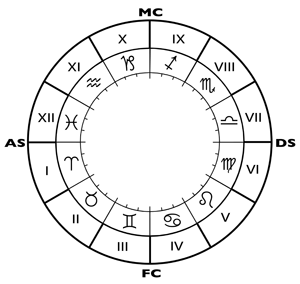 Few symbolist astrologers have offered coherent and systematic theories to justify the meanings attributed to the Houses. For most authors and schools of astrology, the meanings attributed to the Houses or sectors of the local sphere have their source in the analogy which is made between the annual zodiacal cycle of the planets (in the Aries-Pisces sense) and their cycle nychthemeral (in the direction AS-MC-DS-IC). this relation of analogy is the following:
Few symbolist astrologers have offered coherent and systematic theories to justify the meanings attributed to the Houses. For most authors and schools of astrology, the meanings attributed to the Houses or sectors of the local sphere have their source in the analogy which is made between the annual zodiacal cycle of the planets (in the Aries-Pisces sense) and their cycle nychthemeral (in the direction AS-MC-DS-IC). this relation of analogy is the following:
▶ the horizontal plane (AS-DS axis) corresponds analogously to the equinoctial plane (axis 0° Aries/0° Libra);
▶ analogously to the meridian plane (MC-IC axis) corresponds the solstitial plane (axis 0° Capricorn/0° Cancer).
This analogy is explained by the fact that at the beginning of the systematization of astrological knowledge, there was no system or doctrine of the Houses as they exist today. The birth of housing systems and therefore of Houses was a fairly late phenomenon. In the oldest texts (and even in relatively recent ones like that of the Tetrabiblos of Ptolemy, 2nd century AD), it is also striking to note that the words “Sign” and “Home” seem interchangeable. However, they did not show any confusion between these two objects, since in antiquity the Houses had not yet been imagined as divisions of the local sphere. Nevertheless, it is because of this apparent confusion between these two objects that the analogy has subsequently perpetuated, even becoming a sacred cow of astro-traditionalism.
 These two planes delimit four quadrants, themselves subdivided into three sectors or quadrants:
These two planes delimit four quadrants, themselves subdivided into three sectors or quadrants:
▶ the fourth going from AS to IC containing the Houses I-II-III corresponds to the Signs of Spring (Aries-Taurus-Gemini);
▶ the fourth going from IC to DS containing the Houses IV-VI-VI corresponds to the Signs of Summer (Cancer-Leo-Virgo);
▶ the fourth going from the DS to the MC containing the Houses VII-VIII-IX corresponds to the Signs of autumn (Libra-Scorpio-Sagittarius);
▶ the fourth going from MC to AS containing the Houses X-XI-XII corresponds to the Winter Signs (Capricorn-Aquarius-Pisces).
Curiously and always by pure analogy, each of the Axes and Quadrants have been assigned the four Elemental qualities which qualify the Signs of the zodiac (see diagram opposite), just like the Houses, and these attributions lead to the same illogicalities as for the zodiac. Thus, for example, the AS-MC quadrant, governed by the Warm and Humid Air Element, hosts House X, of Cold and Dry Earth and House XII, of Cold and Humid Water. It is better not to try to understand.
The table below summarizes the structural characteristics of the Houses according to classical astrology.
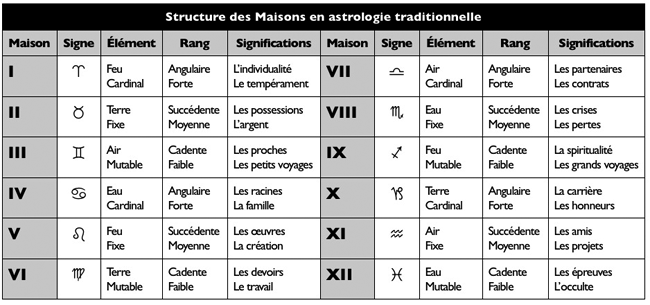
The causes and reasons that presided over the distribution of these correspondences which derive the meanings of House I from those of Aries, those of House II of Taurus, etc., are purely and simply a matter of “law of analogy” so dear to astro-symbolists: no objective astronomical reality founds or justifies them. It should be noted that in the Tetrabiblos of Ptolemy (2nd century A.D.), only brief mention is made of any twelve House system. This work is however a compilation which is intended to be exhaustive of all the astrological knowledge of the time. We know that Manilius (who lived around 50 BC to approximately 15 AD), author of a book, Astrologiques, which also made extensive use of the astrological knowledge of its time, used an 8-house system. This is not to say that the systematic division of the local sphere into twelve sectors did not exist at that time. Some authors think that Ptolemy used the “Porphyry system”, which is that of “Equal houses” (the MC/IC axis is found on the degrees of the zodiac which are at 90° from the AS, and the twelve Houses result from the division into three equal parts in space of the quadrants thus delimited). But in reality in the Almagest, his book of astronomy, we see that he uses a house system which will later be attributed to Placidus. I am not a historian of astrology, and therefore cannot say at what precise time the doctrine of the twelve Houses appeared. I simply observe that between 50 BC and 150 AD, there were probably eight house systems and twelve house systems.
What meanings were given to them then? I do not know. But the numbers speak for themselves at the structural level: a base 8 system could not produce the same meanings as a base 12 system, and above all did not allow any analogical identification with the 12 Signs of the zodiac which, them, had long since been identified. From all this there emerges at least one logical and rational conclusion: the analogy Signs-Houses which founds the meaning of the latter according to so-called “traditional” astrology does not exist for all eternity and is not an untouchable dogma.
You don’t need to be a historian to see that most symbolist astrologers content themselves, in order to explain the influence and meaning of the Houses, with the analogy they make between the 1-year zodiacal cycle and the cycle 1 day nychthemeral, arbitrarily deciding that at the AS “matches” the 0° Aries. To understand the traditional meanings of the Houses, it is therefore necessary to refer to the meanings of the Signs of the zodiac…
Our astrologer ancestors were not as subtle psychologists as some of us. The formal analogy between 0° Aries and AS being made, everything flows naturally: what happens in a day (successive passages of the planets in the 12 Houses) is analogous to what happens in a year (successive passage of the Sun in the 12 Signs).
Aries was considered stupidly quick in its reactions and very individualistic: let’s go for a House I which would mean the way in which the individual expresses himself immediately. Taurus was thought to be materialistic and possessive: we can therefore grant House II, which is analogous to it, money and possessions. Gemini is considered to be spontaneously open in all directions? Go for a House III devoted to curiosity, studies and relations with the entourage, etc. No need to continue this picturesque list, which you will find in all most astrology books.
The classic enumeration of the traditional meanings of the Houses covers quite well some of the various “fields of experience” that each of us can face throughout our lives. One wonders all the same what is the internal logic of such a catalog at the Prevert… Hence the search for a model that would at least account for the coherence of these attributions in terms of the internal logic of this system.
Most symbolist astrologers agree on two points: the Houses would be “fields of experience” which would specify in which elective domain the influence of a planet in Sign is exercised, and the twelve Houses can be classified into three groups: the angular (I-IV-VII-X), the succeeding (II-V− VIII-XI) and the cadentes (III-VI-IX-XII). The Angular Houses are considered to be the strongest and most rewarding for the Planets and Signs that occupy them; then come the successors, then the cadents. Problem: this theoretical assertion is contradicted by experience and statistics, which show that the most rewarding areas of the local sphere for the Planets and Signs found there are located around points AS, MC, DS and IC, and not inside of the angular Houses I, X, VII and IV.
The problem of the correlation between Houses and zones of planetary valuations has been dealt with in the article devoted to The History of the Rating of Planetary Powers. We will therefore not return to it here, except in the form of the following two diagrams. The one on the left represents the zones of zodiaco-planetary valuations according to the Angular-Succedent-Cadente trio, and the one on the right the valuations actually observed.
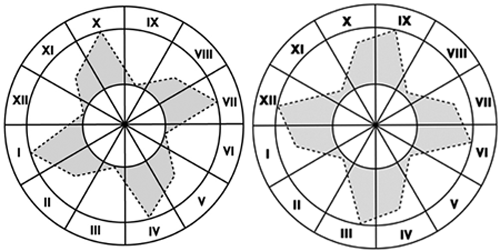
The angular-succeeding-cadent trio, linear and chronological, can be a source of attribution of meanings. For the astrologer humanist Dane Rudhyar for example, the angular Houses are in common the verb “to be”, the successors to the verb “to use” and the cadents the verbs “understand or transform”. In fact, anti-systematic as possible, the majority of symbolist astrologers are satisfied with the chronological enumeration of the meanings of the twelve Houses, without asking themselves if there is a systematic logic, internal or external, continuous or discontinuous, which would structure these meanings.: asking too many questions is tiring… It is the reign of absolute arbitrariness.
The nature of the Houses and the meanings attributed to them are not, far from it, unanimous among astrologers: “The reality of the Houses or sectors of the local sphere is indefinite. Are they portions of space, portions of time (durations), spatial directions, projections? This indeterminacy explains the plurality of systems proposed” (Jean-Pierre Nicola).
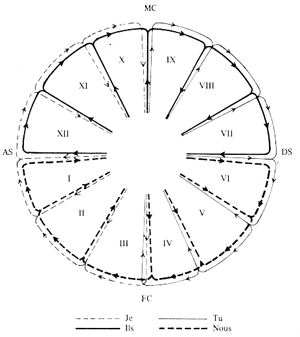 The first conditionalist to look at the problem of the meanings of the Houses and to try to make a systematic modern theory of it was Max Lejbowicz. Assuming that the Houses would be directions in space (see fig. opposite, whose arrows on the circumference respect the diurnal movement while the Houses are numbered classically in the real direction of rotation of the Planets), found an analogy between, on the one hand, the Ascendant/Descendant axis and the dialectic of “I” (introversion) and “You” (extraversion), and on the other hand the Middle-of-the-Heaven/Back-of-the-sky axis and the dialectic of “They” (convergence of the worlds of “I” and of the “You” in the sense of expansion) and “We” (convergence of the worlds of “I” and of the “You” in the sense of intensification), specifying that “the qualification of these directions can only be empirical for the moment and is akin to symbolism; but it is legitimate insofar as it agrees with astrological practice and that of various disciplines (graphology, audio-phonology, etc.”
The first conditionalist to look at the problem of the meanings of the Houses and to try to make a systematic modern theory of it was Max Lejbowicz. Assuming that the Houses would be directions in space (see fig. opposite, whose arrows on the circumference respect the diurnal movement while the Houses are numbered classically in the real direction of rotation of the Planets), found an analogy between, on the one hand, the Ascendant/Descendant axis and the dialectic of “I” (introversion) and “You” (extraversion), and on the other hand the Middle-of-the-Heaven/Back-of-the-sky axis and the dialectic of “They” (convergence of the worlds of “I” and of the “You” in the sense of expansion) and “We” (convergence of the worlds of “I” and of the “You” in the sense of intensification), specifying that “the qualification of these directions can only be empirical for the moment and is akin to symbolism; but it is legitimate insofar as it agrees with astrological practice and that of various disciplines (graphology, audio-phonology, etc.”
In this hypothesis, the planets with the Ascendant would rather operate in a “introvert”, the nature of these planets revealing the priority and dominant expression of the “me I”. The planets in the Descendant would inherit an extraversion function and tell us about how we “let’s use familiar terms” the Other, the outside world. The planets in higher culmination (MC) would be related to our domain of greatest expansion (the “They” of socio-professional life, our most visible part) and the lower culminating planets our domain of greatest concentration (the “We” of the private, intimate life where we find ourselves “with family”, as opposed to the pure exteriority of the “They”).
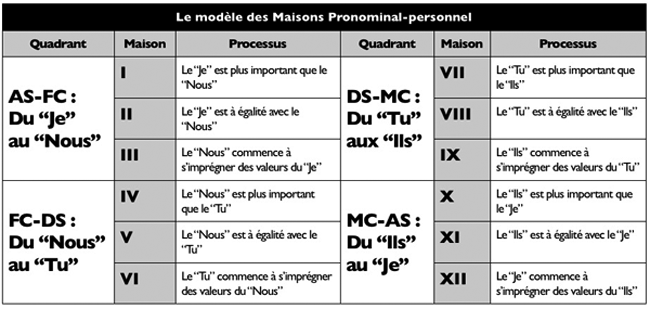
The meanings attributed to each House are induced by those given to these directions AS-MC and DS-IC. Thus, House I would inform us about our attitudes when the “I” is more important than the “We” (self-affirmation is done to the detriment of affiliations), House II concerning the equality of “I” and of the “We” (self-affirmation in interdependence with affiliations), and House III the impregnation by the “I” values of “We” (while asserting oneself, one feels an integral part of a closed whole), etc. You can yourself, by appealing to the internal logic of this system, reconstitute the meanings of the other Houses… and realize that we thus fall back on certain main lines of the traditional meanings. Without going so far as to systematically use this system, you can retain only the four angles (AS-MC-DS-IC) of the local sphere to check for yourself, experimentally, if its main lines of the system “I-They-You-We” are relevant.
From another point of view, we can also consider that the planets located in the diurnal Houses (from VII to XII) are more “extroverted” (diurnal = excitement), and therefore participate more in our external life than the planets in nocturnal Houses (from I to VI), more “introverted” (nocturnal = inhibition), more focused on the interior, intimate or private life.
Without providing a definitive answer to these questions, the astrologer J.-P. Nicola proposed an original system, based on the interactions between the R.E.T. and the S.O.R.I. This system poses a number of problems.
From 1964, the year of the publication of The Solar Condition by Jean-Pierre Nicola, the founding work of conditionalist astrology in 1977, the year of the publication of Introduction to conditional astrology by Max Lejbowicz (ed. C.E.F.A.) the problem of the significance of the Houses remained in research, fallow. In 1977, two different models are proposed: that of Lejbowicz (see above) (published at the beginning of 1977, it appears in the Manuel d’astrologie universelle) and that of J.-P. Nicola, which first appeared in the review Astrologique, at the end of 1977, when For a modern astrology.
About this book published in 2nd quarter of 1977, J.-P. Nicola also notes that he still confused R.E.T. and S.O.R.I. Initially, he assigned the repository “Subject” At ‘R’ level, the “Object” at the level ‘E’, and the “Relationship” at the level ‘T’. In For a modern astrology, “It is Mars and ‘E’ level which receive the ‘Relationship’… on condition of calling ‘Object’ the real beyond appearances”. Where did the problem come from? From the non-differentiation, at that time, between R.E.T. and S.O.R.I.. To tell the truth, the S.O.R.I., did not exist as such at the time: it was rather a “S.O.R.”, the concept of “Integration” having only appeared a little later.
It was therefore during 1977 that J.-P. Nicola formally differentiated the two systems. He thus finds himself with a ternary system (the R.E.T.) and a quaternary system (the S.O.R.I.). Four times three, it is well known, that makes twelve, that is the number of Signs and Houses. The zodiac meanings being already explained through the intermediary of the reflexological zodiac: it is to the mysterious Houses that the combined system R.E.T./S.O.R.I. Let us quote the words of J.-P. Nicola on this subject: “Returning to the houses (in anticipation of an article), the simple, major side, of the angular Houses imposing the ‘R’. By following the order AS-Subject, MC-Object, DS-Relation… the IC delivered the word Integration which was missing to stop looking for the S.O.R.I. in the R.E.T.”
The “S.O.R.”, uncertain doublet of the R.E.T. thus existed before the explanatory “Nicola” of the Houses, but not the S.O.R.I. The concept of “Integration” is, according to him, born of a hypothesis aimed at rationally and methodically explaining and founding, thanks to the R.E.T.-S.O.R.I. combination, the system of meanings of the traditional Houses. In traditional astrology House IV and IC are indeed the symbolic place of the home, the family, the roots, the mother. From this symbolism could effectively be extracted the concept of “Integration”.

On a theoretical level, it is only by relating the different levels of these two reference systems that the specificity of each gradually emerged: through the R.E.T./S.O.R.I. Houses, concepts such as the “T of Subject”, the “R of the Object” where the “E of Relationship” made it possible to get out of the pitfalls of the analogy between R.E.T. and S.O.R.I. Moving from theory to its practical applications, conditionalist researchers and experimenters then realized that indeed, a solar could work in “Relationship”, A marsian in “Integration”, A lunar in “Object” and one plutonian in “Subject”., to take just a few examples.
The R.E.T. and the S.O.R.I. were then definitively differentiated, and J.-P. Nicola was thus able to write that “the S.O.R.I., while expressing itself formally and partially (emphasis mine) in the Houses, more than the R.E.T. an ideal model for getting out of astrology, entering into a meta-astrology: the rich future of conditionalism.” In this sense, the S.O.R.I. model, born from a reflection on the distribution of the Subject, Object and Relation references within the R.E.T. and supplemented by its application to the definitions of the sectors of the local sphere, gradually broke away from it to embrace wider astro-philosophical horizons, which J.-P. Nicola has never failed to develop in all his writings published since then. the beginning of the 1980s. In 1996, no astrologer who had truly understood and integrated the R.E.T. and the S.O.R.I. does not confuse the ‘R’ and the Subject, the ‘E’ and the Object, etc.
Remember that the angular Houses were considered dominant: the planets found there and the Signs they intercepted were thus clearly valued in relation to the others. The succeeding Houses were considered to be noticeably weaker, less dominant than the angular ones; finally, the Cadent Houses were considered quite debilitating for the Signs and planets who had the unfortunate idea of crossing them. The R.E.T. made it possible to simply analyze the internal logic of this system based on the decrease in power: strong signal (‘R’) followed by an average signal (‘E’), itself followed by a weak or subtle signal (‘T’):
▶ the traditional Angular Houses obviously belong to the ‘R’ level (strong signal, hyper-valorization, planets and Signs considered to be ultra-representative of the Subject).
▶ the succeeding Houses come under ‘E’ level: less strong signal, less obvious, less rewarding.
▶ the Cadent Houses come under the ‘T’ level: weak signal, extreme discretion of the Signs and Planets found there.
Formally, there is nothing to say: the analysis is coherent, and our astrologer ancestors did indeed work according to an R.E.T. logic. unconscious when they structured the sectors of the local sphere in this way. Practically, it’s something else. The observations of practitioners of astrology, confirmed by statistical studies, have shown that the zones of angularity of the planets are located on either side of the four axes of the local sphere. In other words, the planets considered dominant in the chart are certainly found partly in the angular houses, but also in the cadent houses, considered debilitating and devaluing. The basic principles of conditionalist ranking methods confirm this fact.
A problem of formal logic then appears: on the one hand, how could ‘T’ Houses such as the XII, IX, VI and III contain planets considered as ‘R’ (dominant) in the functioning of the individual? On the other hand, observation and clinical and statistical studies have shown us that the planets located at the end of the ‘R’ Houses (I-IV-VII-X) are not dominant. Finally, the succeeding Houses have statistically appeared as the least rewarding for the planets therein, while the astrological tradition like the R.E.T. applied to the Houses assign them an average power…
The diagram below illustrates this major and prohibitive problem of consistency between theory and practice. On the left, the recovery areas (central gray star) according to the R.E.T./S.O.R.I. On the right, the experimentally and statistically found valuation zones. The problem is therefore exactly the same as with traditional Houses.
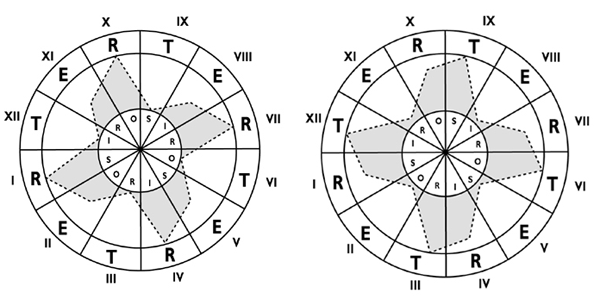
We will come back to it. For now, note that the distribution of S.O.R.I. in the sectors of the local sphere is completely arbitrary. Nicola’s definitions, precise and concrete, allow experimental verification thanks to systematic groupings: Houses/triangles of the Subject (I-V−IX) of the Object (II-VI-X), of the Relationship (III-VII-XI) and Integration (IV-VIII-XII), and House-squares of Representation (I-IV-VII-X), Existence (II-V−VIII-XI) and Transcendence (III-VI-IX-XII). It is up to you to judge to what extent they allow or not to justify the meanings empirically attributed to the Houses.
The system of the S.O.R.I./R.E.T. Houses, based on analogies and lacking experimental confirmations, remains very largely hypothetical and is perhaps only a logical chimera. To convince you, here is an anthology of quotes from J.-P. Nicola on this subject:
“There is little chance (in my opinion none) that the ‘field of influence’ of the diurnal motion is a continuous linear decreasing function… as proven (for those who believe in it) by the Gauquelin and Lasson statistics (we won’t not from one rise to the next rise by a decreasing line or curve but by a succession of troughs and peaks, or by periodic functions)”
“The statistics tend to show a shift of the maxima towards the center of the 12th and 9th houses and towards the beginning of the 7th and 4th houses. These shifts change the boundaries of the Houses without affecting the logic of the meanings.”
“A detective capable, by his deductions, of reconstructing the motives and the author of a crime, does not provide proof that he is the accomplice. It is abusive and misleading to make (him) say that (he) adheres to a system on the pretext that (he) dismantles some cogs.”
“Whatever system of division of the local sphere the conditionalist school will adopt, the meanings are defined by the R.E.T. applied to its four frames of reference” (p. 30 of the Anthologie astrologique 1980–1986)
“Anyway, I remind you that I am not proposing a new system of Houses but that I am dismantling and demonstrating the internal logic of the classic attributions”
“It is not necessary to believe in the effectiveness of these sectors, nor to limit their extents exactly, in order to analyze their semantic contents… Most of the conditionalists believe that the astrological Houses defined in S.O.R.I. are not enough to really testify to an effective plan of the personality, of his or her preferences”
“The adapted formula of the Sign strengthens the planetary function to overcome the sectoral barriers of the Houses”.
“Although the S.O.R.I. was discovered by the R.E.T. applied to the traditional meanings of the Houses, for the majority of the conditionalists these testify to it, practically, only in a purely indicative way, rather than a tendency: a possibility which is realized or not only the extra-horoscopic context. Integration is not trapped in the horoscope.”
“Houses I-X-VII-IV are in affinity with the ‘r’ planets… Houses II-V−VIII-XI are in affinity with the ‘e’ planets… Houses III-VI-IX-XII are in affinity with the ‘t’ planets… We can also say that the ‘r’ planets lack affinity with the ‘t’ planets and sectors. They prefer the Subject to Integration (too complex).”
“The astonishing part of the paradox would be to have drawn from the meanings of the Houses a S.O.R.I. which, applied to their interpretation, would yield nothing. Imagine the discovery of an ore on land that does not exist… Possible, but surprising… It is surely established that the scope of the S.O.R.I. goes far beyond the horoscope… to the point, precisely, of forgetting that it is there.”
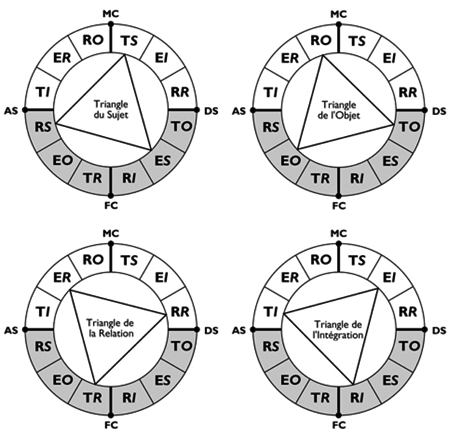
This is all very theoretical. So let’s move on to practice and observation. When J.-P. Nicola proposed his model R.E.T./S.O.R.I. to account for the meanings of the Houses, I had nothing against a priori: most of the concepts and methods that he had discovered or imagined to define more closely the astrological reality had appeared to me, after systematic experimentation, perfectly adequate and sensible. The only thing that bothered me was to see that the Integration, resulting from the globality of Subject-Object Relations, could be contained in three Houses, that is to say 25% of the local sphere. But I said to myself that it was perhaps a question of a partial, relative integration, very different from the “great Integration” of the macro-S.O.R.I. extra-Houses, as different from the latter as Integration in the family environment can be from that in the national, terrestrial or cosmic environment… I therefore tested this system by applying it to many charts of friends and celebrities, going through interviews, biographies and autobiographies as I have always done since I studied astrology. I also tested the Houses R.E.T./S.O.R.I. in consultation, trying to see if it allowed me to assess with a good margin of precision if the people I had in front of me were rather “Subject” (subjective) or “Object” (objectives), etc.
The experimentation was relatively simple: a chart with a clear dominance of Houses “Subject” (I-V-IX) was to induce in its possessor a subjectivity clearly above the average; a clear dominance of Houses “Object” (II-VI-X) implied that the individual clearly demonstrated behaviors and reasoning bearing the seal of objectivity. Result of these long searches: it is not so. Experience allows me to affirm (I am not the only conditionalist to do so) that it is impossible, with the R.E.T./S.O.R.I. Houses, to know if an individual is “Subject” (subjective) or “Object” (objective).
Since then, having thought about this problem, I said to myself that basically, this tedious experimentation was not even necessary. Indeed, it is enough to observe the people around you. The overwhelming majority of us obviously operate and reason with great subjectivity. It is very infrequent to meet people functioning and reasoning objectively, and I am not even talking about Relationship and Integration… A simple statistical reasoning shows that, on a very large number of charts taken at random, the charts to Houses “Subject” Dominants will be as numerous as the charts at Houses “Object” dominant, which means that there would be, according to this system, as many subjective people (25%) as objective people (25%). The observable proportion would be more like 90% subjective, 10% objective, being optimistic… The R.E.T./S.O.R.I. are therefore unable to “plan” (as any good theory should be able to do) an obvious and unmistakable fact.
This argument alone is enough to doubt the validity of the House theory based on the R.E.T./S.O.R.I. For those who do not find it sufficiently convincing, I will add that in our young years, we are all subjective. It is only with adolescence and especially adulthood that some of us (a small minority) manage to get out of this infantile subjectivity to access a minimum of objectivity. The attainment of objectivity is therefore not innate, but the result of a dynamic process that takes place over time… and the Object cannot be trapped in the Houses either… not more than the Subject, since according to the fundamental formula of J.-P. Nicola himself, “the horoscope is not the subject”.
The problems with the meanings of the Houses are far from simple, and even further from solved. For my part, I must admit that I have completely eliminated any reference to the Houses in my practice (except in the field of planetary hierarchy of course). My vain research has so far discouraged me from trying to find other coherent and above all realistic explanatory models. The question therefore remains unanswered for the time being. On the other hand, it is quite interesting to use the relationship between R.E.T. and S.O.R.I. on a noological or philosophical level, independently of their application to the Houses.
And anyway, the S.O.R.I. has far too vast a conceptual, universal and extra-astrological scope to be reduced to a vulgar household problem.
First of all, you can see that we don’t know much for certain about the nature and meanings of the Houses. Two major reasons may explain this state of affairs. The first is that the sectors of the local sphere have no other meaning than symbolic or imaginary. The second is that the influence of the Houses is so weak and so subtle that it is extremely difficult to determine it, to experience it and to discuss it without betraying it. It’s probably the second reason that is the right one… but for now, the mystery remains thick.
Whatever the reason, the importance of the Houses should therefore not be overestimated. If they have no real meaning, of course. If they have one, which is likely, it is at present still veiled and enigmatic. In the interpretation of a chart, it is therefore better to evoke “with dots” the meaning of the Houses, to avoid betraying reality with false explanations.
Exaggerating the importance of the Houses can even lead to perfect misinterpretations. Let us take the example of the system of meanings of the Houses proposed by Max Lejbowicz: a Jupiter in the Ascendant will act anyway on the four planes “I-You-They-We”. If in the same chart Saturn is found in the Descendant, you would make a serious error of interpretation by thinking that the Subject will be saturnian in its “familiarity” of the outside world (House VII) and jupiterian in its self-affirmation (House I). A jupiterian dominance implies that one will function as a Jupiterian in love as in business, when traveling as at home, with his brothers as with his friends. The same goes for any planet that dominates in the chart and in the experience, whatever its position in the House. Ditto for the R.E.T./S.O.R.I.
If you absolutely insist on interpreting charts according to a system of meanings of the Houses or the four “Angles” of the local sphere, whatever it is, you will not risk going wrong if you study thoroughly and primarily the planetary and zodiacal configurations. In a second step, you can always cautiously, on an experimental basis, integrate into your interpretation a small dose of Houses… until one day, astrology finally gives birth to a coherent and realistic system to account for the meanings of the sectors of the local sphere.
▶ Le modèle S.O.R.I. et les Maisons
▶ Astronomie des Maisons
▶ Géométrie des Maisons et méthodes prévisionnelles
▶ Le S.O.R.I., le caducée et l’I.R.O.S.
▶ Zodiaque et sphère locale
▶ Carré à l’Ascendant & point nonagésime
▶ Historique de l’évaluation des puissances planétaires
▶ Thème de domitude et hiérarchisation planétaire

Les significations planétaires
par
620 pages. Illustrations en couleur.
La décision de ne traiter dans ce livre que des significations planétaires ne repose pas sur une sous-estimation du rôle des Signes du zodiaque et des Maisons. Le traditionnel trio Planètes-Zodiaque-Maisons est en effet l’expression d’une structure qui classe ces trois plans selon leur ordre de préséance et dans ce triptyque hiérarchisé, les Planètes occupent le premier rang.
La première partie de ce livre rassemble donc, sous une forme abondamment illustrée de schémas pédagogiques et tableaux explicatifs, une édition originale revue, augmentée et actualisée des textes consacrés aux significations planétaires telles qu’elles ont été définies par l’astrologie conditionaliste et une présentation détaillée des méthodes de hiérarchisation planétaire et d’interprétation accompagnées de nombreux exemples concrets illustrés par des Thèmes de célébrités.
La deuxième partie est consacrée, d’une part à une présentation critique des fondements traditionnels des significations planétaires, d’autre part à une présentation des rapports entre signaux et symboles, astrologie et psychologie. Enfin, la troisième partie présente brièvement les racines astrométriques des significations planétaires… et propose une voie de sortie de l’astrologie pour accéder à une plus vaste dimension noologique et spirituelle qui la prolonge et la contient.
Téléchargez-le dès maintenant dans notre boutique

Pluton planète naine : une erreur géante
par
117 pages. Illustrations en couleur.
Pluton ne fait plus partie des planètes majeures de notre système solaire : telle est la décision prise par une infime minorité d’astronomes lors de l’Assemblée Générale de l’Union Astronomique Internationale qui s’est tenue à Prague en août 2006. Elle est reléguée au rang de “planète naine”, au même titre que les nombreux astres découverts au-delà de son orbite.
Ce livre récapitule et analyse en détail le pourquoi et le comment de cette incroyable et irrationnelle décision contestée par de très nombreux astronomes de premier plan. Quelles sont les effets de cette “nanification” de Pluton sur son statut astrologique ? Faut-il remettre en question son influence et ses significations astro-psychologiques qui semblaient avérées depuis sa découverte en 1930 ? Les “plutoniens” ont-ils cessé d’exister depuis cette décision charlatanesque ? Ce livre pose également le problème des astres transplutoniens nouvellement découverts. Quel statut astrologique et quelles influences et significations précises leur accorder ?
Enfin, cet ouvrage propose une vision unitaire du système solaire qui démontre, chiffes et arguments rationnels à l’appui, que Pluton en est toujours un élément essentiel, ce qui est loin d’être le cas pour les autres astres au-delà de son orbite. Après avoir lu ce livre, vous saurez quoi répondre à ceux qui pensent avoir trouvé, avec l’exclusion de Pluton du cortège planétaire traditionnel, un nouvel argument contre l’astrologie !
Téléchargez-le dès maintenant dans notre boutique